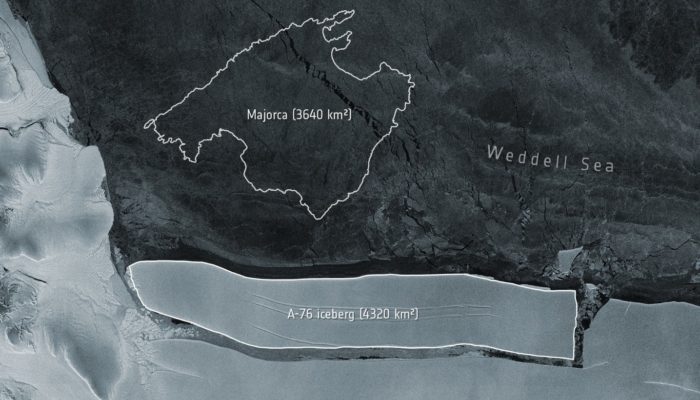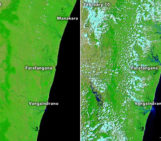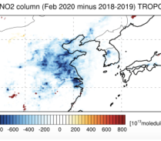
The largest iceberg in the world, named A-76, about 170 km long and 25 km wide, is drifting away from the Ronne pack ice in Antarctica. A76, originally spotted by the British Antarctic Survey (BAS), a British polar research organization with a base nearby, will wander and melt in the Weddell Sea, according to a statement released Wednesday, May 20, by the European Space Agency.
Several studies are confirming that anthropogenic emissions result in a significant increase in the loss of ice from global Ice Sheets, although we cannot link each single iceberg formation to climate change. “Periodic calving of large chunks of ice shelves is part of a natural cycle, and breaking off of A-76 is not linked to climate change”, Ted Scambos, a research glaciologist at the University of Colorado in Boulder, said, according to Reuters. “Because the ice was already floating in the sea before dislodging from the coast, its break-away does not raise ocean levels” continues Scambos.
The reason why the single Iceberg formation cannot be attributed to climate change is probably due to the difficulty of studying polar regions: the monitoring and tracking of polar icebergs is possible only thanks to the recent development of satellites. In the last 40 years we could detect only about 5 icebergs of the same size of A-76. The variability of the polar weather makes it difficult to discern trends in iceberg dynamics from fluctuations due to natural phenomena.
Nonetheless worrying results come from the scientific community: mathematicians at the University of Sydney have shown that icebergs are melting faster than current models describe. Their findings are based on a new model to more accurately represent the melt speed of icebergs into oceans. Lead author and PhD student Eric Hester said: “While icebergs are only one part of the global climate system, our improved model provides us with a dial that we can tune to better capture the reality of Earth’s changing climate. In icebergs moving in oceans, the melting on the base can be up to 30 percent faster than in old models.”
A misrepresentation of some elements of the cryosphere, such as the icebergs, could hide tipping elements of the climate system: a tipping point in the climate system is a threshold that, when exceeded, can lead to great changes in the state of the climate. Two global tipping elements concerning the cryosphere, namely the irreversible melting of the ice caps of Greenland and Antarctica. In Greenland, a positive feedback cycle exists between melt and surface elevation. At lower altitudes, temperatures are higher, resulting in additional melting. This feedback loop could become strong enough to cause irreversible melting. The instability of the pack ice could trigger a tipping point in West Antarctica. Either way, this would accelerate the rise in sea levels. Due to their importance for the climate system and their effect on ecosystems and society, international research projects such as TIPES are trying to understand climate tipping points



